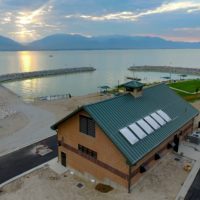
Saratoga Springs Marina Pump Station
HAL planned, designed, and oversaw construction of a 10,000 gpm irrigation pump station adjacent to Utah Lake. The new project provides water to the City’s growing southern area and allows the City to utilize Utah Lake water rights rather than canals.
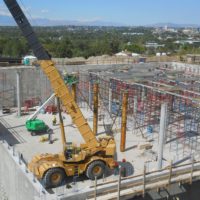
Provo City 4 MG/8 MG Water Tanks and 24″/30″ Pipelines
HAL completed a detailed hydraulic analysis to refine proposed storage locations and piping modifications. Following the analysis, HAL provided engineering services for the design, bidding, and construction of two new storage tanks and transmission pipelines.
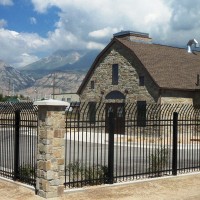
CWP High-Head Wells Project
The Central Utah Water Conservancy District contracted HAL to plan, design, and manage a groundwater development project that will supply water to some 160,000 people. The project is the largest of its kind in Utah, with some of the state’s largest and deepest wells.
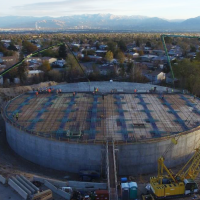
Kearns Improvement District 5 MG Tank and 30″ Pipeline
HAL helped Kearns Improvement District design and permit a new water tank and pipeline on a busy site while maintaining access, water service, and public acceptance during construction.

Salt Lake City Storm Drain Master Plan
HAL is assisting the Salt Lake City Department of Public Utilities in a storm drain master plan that responds to Utah’s new MS4 regulations and includes considerations for Low-Impact Development (LID).
Read more: HAL helps Salt Lake City and others comply with new stormwater regulations

Columbia River Winter Operations Study
The Columbia River system, lifeblood of the Pacific Northwest, contains over 60 dams. HAL assisted the U.S. Army Corps of Engineers with a winter operations study using HEC-ResSim and custom scripts.
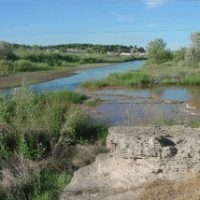
Humboldt River Floodplain Analysis
HAL assisted Elko City, Nevada, with flood delineation and flood mitigation projects. The effort included detailed hydraulic analysis of a reach of the Humboldt River, plus analysis and design of flood mitigation measures on Metzler Wash, Culleys Gully, and Eight Mile Creek. HEC-RAS water surface profiles were used to analyze existing flooding potential and evaluate alternative mitigation measures. Letters of Map Revision (LOMRs) were successfully submitted to FEMA for the projects resulting in improved floodplain conditions.

Water Rights Support
For over 40 years HAL has provided water rights engineering support to municipalities, private clients, and over 20 legal firms in Utah and Idaho. Services have included due diligence and site investigations supporting land purchases, surface and groundwater studies, water use evaluations, water right ownership evaluations, new filings, diligence claims, change applications, proof of appropriation, proof of beneficial use, and water right hearing support.
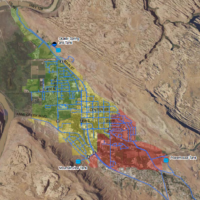
Moab Water Master Plan, CFP, IFFP, and IFA
The City of Moab is experiencing considerable pressure from new residential and commercial growth. HAL partnered with Zions Public Finance for a series of plans and assessments. HAL performed planning and modeling for the capital facilities plan (CFP) and impact fee facility plan (IFFP). Zions Public Finance took HAL’s IFFP to the next step by preparing an impact fee assessment (IFA) and rate study.
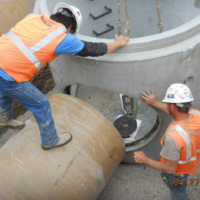
Mount Olympus Improvement District Wastewater Master Plan
The Mount Olympus Improvement District provides wastewater collection services for over 114,000 residents. HAL assisted the District in preparing a master plan to assess current conditions in the existing wastewater collection system, identifying needed improvements, analyzing impact fees, planning for future growth, and developing a list of capital facilities that will be needed.

Springville City Wastewater Collection System Master Plan
Springville City provides wastewater collection services for 30,000 residents. HAL assisted the City in preparing a master plan to assess current conditions in the existing wastewater collection system, identifying needed improvements, planning for future growth, and developing a list of capital facilities that will be needed.
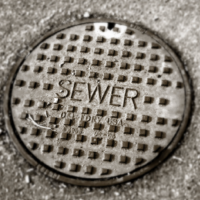
Tooele County Wastewater Regionalization Plan and Septic System Density Study
After years of rapid development of areas without sanitary sewer systems, Tooele County asked HAL to evaluate the impact of septic system discharges into groundwater. HAL employed hydrogeologic data and modeling of horizontal, vertical, and dispersion flows in a mass-balance approach with risk analysis to determine septic system densities that would prevent excessive groundwater nitrate concentrations.
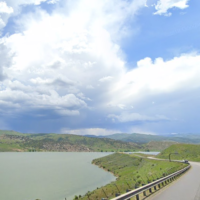
Summit County Septic System Density Studies
Summit County Health Department retained HAL to evaluate the Henefer Valley, Coalville/Hoystville/Wanship Valley, and Kamas Valley aquifer systems to determine appropriate septic system densities to prevent excessive groundwater quality degradation. HAL developed a risk-based approach to the mass balance and further supported the justified septic system density limitations through additional research.

Spanish Fork Pole Canyon Septic System Density Study
HAL prepared a Septic System Density Study for the Pole Canyon drainage area, which is the recharge area for Spanish Fork City’s Cold Springs. HAL researched historic water quality data and performed water quality sampling for comparison to determine the impact of existing septic systems in Pole Canyon on the springs. A detailed hydrogeologic evaluation coupled with the water quality data provided a basis for determining septic system density limits that would protect the City’s drinking water source from excessive water quality degradation.
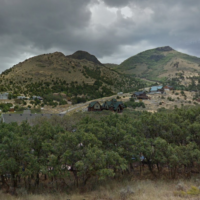
Arnold Hollow Septic System Management Program
HAL helped Herriman City develop a management program for septic systems within the Arnold Hollow drainage southwest of the City. Development within Arnold Hollow is a concern to the City because it is the recharge area for the City’s drinking water springs and there are no sewer collection facilities in the area. The program included research and evaluation of existing water quality, characterization of groundwater flow conditions, establishment of maximum septic system densities, and development of a program for approval of selected alternative septic systems that reduce nitrate concentrations in septic system effluent.

South Salt Lake Vulnerability Assessment
HAL performed the Vulnerability Assessment (VA) for all of the City’s water system facilities following the Bioterrorism Act of 2002. The scope of work included assisting with the prioritization of the water system facilities, determination of the Design Basis Threat, evaluation of the consequence for the loss of each facility, evaluation of the effectiveness of the existing protection systems, calculation of the relative risk to each facility, and generation of recommendations to reduce the risk at each facility. Site visits were made to each facility to verify critical assets and existing protection systems.

Granger-Hunter Improvement District Vulnerability Assessment
HAL performed the Vulnerability Assessment (VA) for all of the District’s facilities following the Bioterrorism Act of 2002. The scope included prioritization of all of the facilities, determination of the Design Basis Threat, evaluation of the consequence for the loss of each facility, evaluation of the effectiveness of the existing protection systems, calculation of the relative risk to each facility, and generation of recommendations to reduce the risk at each facility. Site visits were made to each of the District’s facilities to verify critical assets and existing protection systems.

Midvale City Vulnerability Assessment
HAL performed the Vulnerability Assessment (VA) for all of the City’s water system facilities following the Bioterrorism Act of 2002. The scope of work included assisting with the prioritization of the water system facilities, determination of the Design Basis Threat, evaluation of the consequence for the loss of each facility, evaluation of the effectiveness of the existing protection systems, calculation of the relative risk to each facility, and generation of recommendations to reduce the risk at each facility. Site visits were made to each facility to verify critical assets and existing protection systems.

Springville City Vulnerability Assessment
HAL performed the Vulnerability Assessment (VA) for all of the City’s water system facilities following the Bioterrorism Act of 2002. The scope of work included assisting with the prioritization of the water system facilities, determination of the Design Basis Threat, evaluation of the consequence for the loss of each facility, evaluation of the effectiveness of the existing protection systems, calculation of the relative risk to each facility, and generation of recommendations to reduce the risk at each facility. Site visits were made to each facility to verify critical assets and existing protection systems.
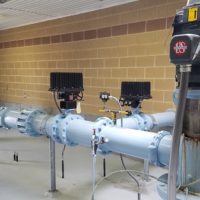
Magna Water Company Vulnerability Assessment
HAL performed the Vulnerability Assessment (VA) for all of the Water Company’s water system facilities following the Bioterrorism Act of 2002. The scope of work included assisting with the prioritization of the water system facilities, determination of the Design Basis Threat, evaluation of the consequence for the loss of each facility, evaluation of the effectiveness of the existing protection systems, calculation of the relative risk to each facility, and generation of recommendations to reduce the risk at each facility. Site visits were made to each facility to verify critical assets and existing protection systems.
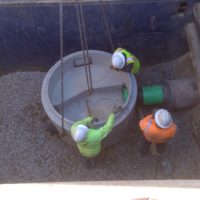
Bangerter Highway Three Interchange Project
The Utah Department of Transportation is reconstructing three intersections along Bangerter Highway to improve traffic flow and safety. The new design requires relocation of existing South Valley Sewer District pipelines. HAL provided study and design of a new sewer route, plus survey, easements, stakeholder involvement, agency coordination, and services during construction.
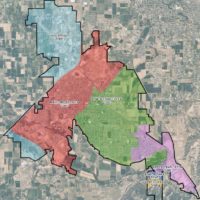
Spanish Fork Water Master Plan
HAL completed a major update to Spanish Fork City’s Drinking Water Master Plan. Key technical issues included understanding the City’s multi-zone water distribution system, projecting water demands that consider the long-term effects of drought and conservation, developing innovative approaches to pipe network modeling, and updating the City’s GIS-based water infrastructure database.
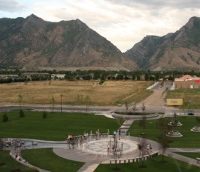
Highland Wastewater Master Plan
Highland City, Utah, has grown rapidly in recent years, straining its wastewater collection system. Consequently, the City desired a master plan that would both address existing system deficiencies and recommend future infrastructure to support further growth. HAL completed a Wastewater Collection System Master Plan with a schedule of capital projects to meet these needs.
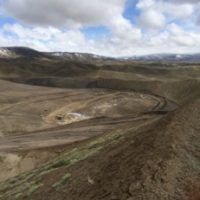
Montrose Landfill Phasing Plans
HAL provided planning for Waste Management at their Montrose, Colorado, municipal landfill that included a phasing plan through the year 2039. HAL used AutoCAD Civil 3D with an existing topographic surface to define the ultimate closure surface and determine construction phases in 5- to 10-year increments. A phased drainage plan was also defined. Waste Management used the plans to prioritize capital improvements and allocate resources to future budgets.